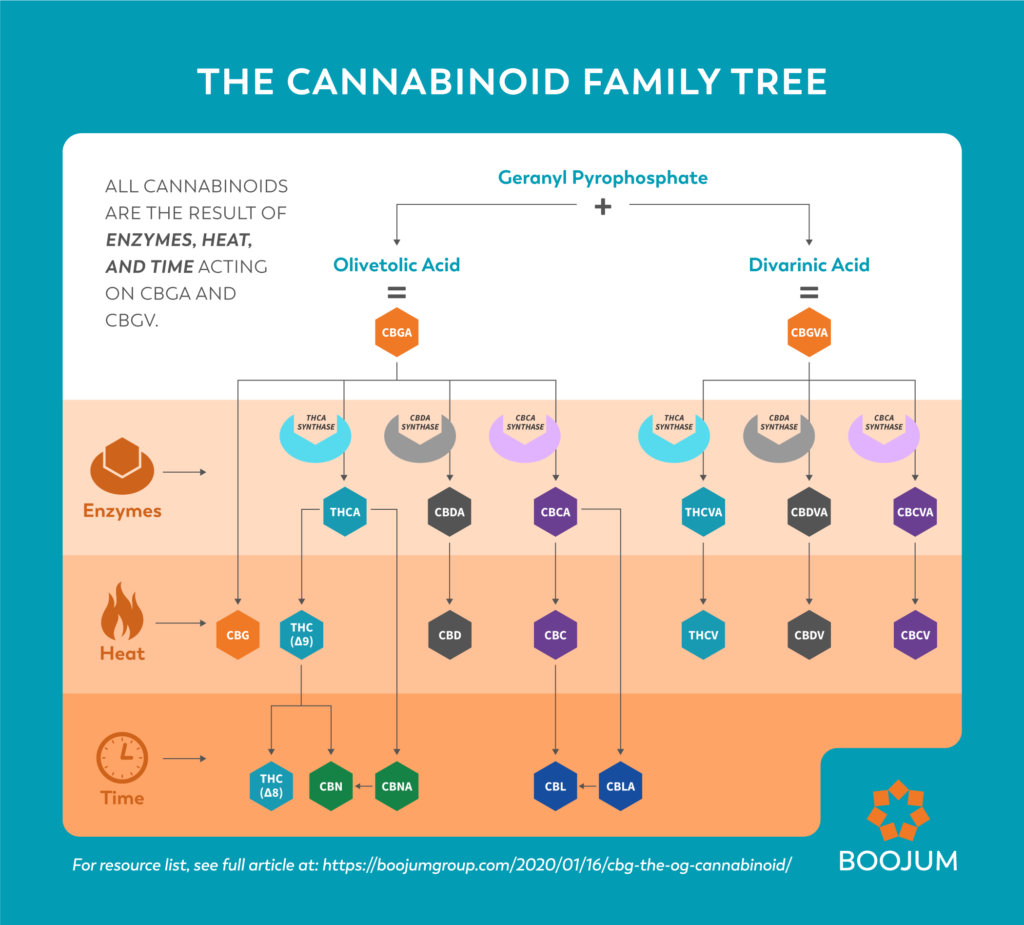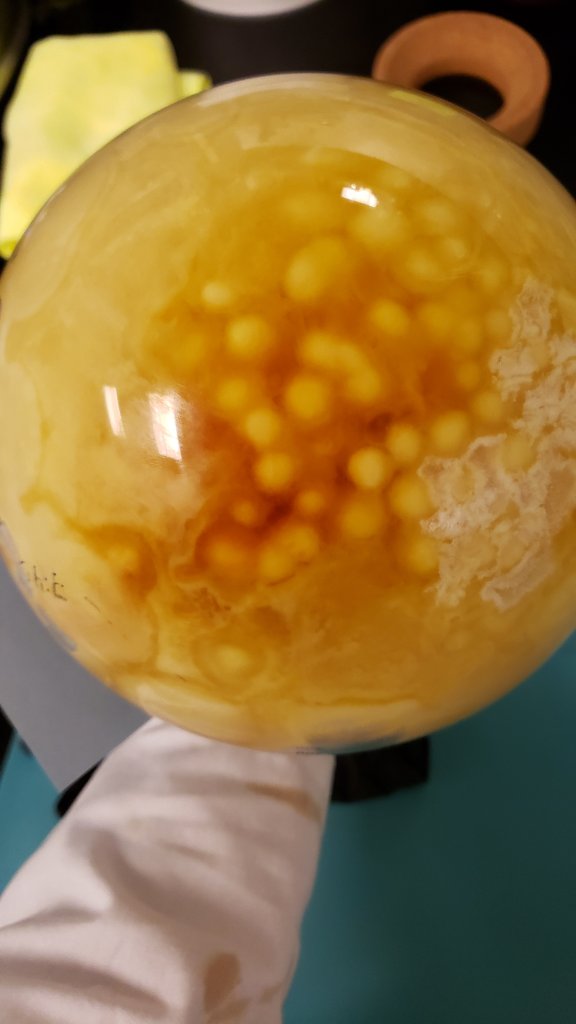The Mother of All Cannabinoids
In the cannabis world, CBD and THC are becoming more understood, recognized, and researched every day. This increased attention has led to an increased interest in the lesser-known, or minor, cannabinoids. Of these minor cannabinoids, Cannabigerol (CBG) has drawn the most attention—and for good reason. CBD, THC, and all the others can be traced back to CBGA (CBG’s acidic precursor), the mother of all cannabinoids. It is the original cannabinoid, and through enzymatic pathways, heat, and time, it becomes all cannabinoids.


Cannabinoid Synthesis
Deep inside the sticky trichomes of the cannabis plant, the magic begins when molecules of geranyl pyrophosphate combine with one of two acids. To create CBGA, olivetolic acid must be introduced. This CBGA molecule then gives rise to the bulk of the cannabinoids that most consumers are familiar with.

When divarinic acid is added instead at this stage, we get CBGVA. CBGVA will eventually become the varin cannabinoids: CBGV, CBCV, CBDV, THCV, and CBV—the V in each alludes to this grouping). We’ll explore the varin cannabinoids more in-depth in an upcoming article, but for now we’ll follow the olivetolic acid, watch it combine with geranyl pyrophosphate, and create CBGA.
Once CBGA has been synthesized from the plant molecules, this primal cannabinoid is then changed into the acidic form of the cannabinoids by enzymes in the trichomes. One specific enzyme turns CBGA into CBDA, another THCA, and a third, CBCA. These acidic forms, along with CBGA itself, can then be decarboxylated—a process that entails removing their carboxylic acids by exposing them to light and/or heat, to create CBD, THC, CBC, and CBG molecules. Most cannabis used therapeutically and recreationally today has been decarboxylated (had the carboxylic acids removed); however, research is growing as is the list of benefits and uses of the acidic versions. Given time, THC may further convert to CBN, while CBC can become CBL. As a precursor to the major cannabinoids, CBGA contains the building blocks of all the major cannabinoids, along with its own decarboxylated version (CBG).
What is CBG Good For?
For this reason, CBGA has been called the “stem cell” of cannabinoids. It has shown promise, along with CBG, in a wide variety of therapies. Many of its benefits are shared with its daughter cannabinoids, but it does show promise for unique therapies as well. Since it interacts with both endocannabinoid receptors CB1 and CB2, CBG has diverse and wide-ranging effects. In addition to boosting anandamide (which regulates mood, sleep, and appetite), and blocking serotonin receptors (which helps lessen depression and anxiety), CBG also inhibits the psychotropic effects of THC by blocking it from the endocannabinoid receptors.
While human trials have yet to be conducted, in-vitro and animal trials show a lot of promise for CBG in treating a variety of conditions. In just the last couple years, research has shown CBG to improve inflammatory bowel disease in mice, reduce chemotherapy-induced cachexia (a wasting syndrome displaying muscle atrophy, anorexia, and metabolic dysregulation), reduce ocular pressure without the side-effects present in other cannabinoids, reduce neuroinflammation and oxidative stress, and even help treat neurodegenerative disorders like Huntington’s Disease.
Harnessing CBG
While CBG is quickly gaining a reputation as one of the most beneficial cannabinoids, research remains relatively scarce. CBG is generally available only at low levels in traditional cannabis strains, and has been long ignored in favor of CBD and THC. Now, as interest across the panel has increased and studies have brought attention to the promise of CBG, it’s likely to garner more investigation. The federal government recently pledged three million dollars towards minor cannabinoid research, and it’s safe to say a good portion of that will go towards elucidating CBG’s role in health and well-being.
Since CBG is usually only available in cannabis at low levels, demand for it remains high. For CBG to be present at more than trace amounts, it needs to be harvested from specific cannabis strains (these are bred to have fewer of the enzymes that would otherwise convert CBGA into other cannabinoids). Even strains bred specifically for CBG have these enzymes, albeit at lower levels, and so plants must be harvested early—when CBGA levels are peaked, and before the enzymes get a chance to synthesize new molecules.
Here at Boojum Group we work with local farmers to find and cultivate high CBG strains, then use laboratory processes designed to help extract and preserve the cannabinoids. Aside from CBG, some of the other minor cannabinoids can be targeted for extraction, and as research expands, so does our understanding of their effects and ability to use them effectively (stay tuned for our upcoming article on CBN). We specialize in creating custom spectrum distillate and products. Our ratios are designed to take advantage of the plant’s unique synergy and entourage effect, and to provide targeted treatment for our clients.
Today, the research community is not only allowed to study cannabinoids for the first time since the discovery of the endocannabinoid system, but is actively and fiscally being encouraged to do so by the federal government and other entities. Preliminary research indicates that CBG and CBGA show great promise in helping patients combat everything from depression and anxiety to chemotherapy side-effects and neurodegenerative disorders. With so much new research, and novel cultivation methods improving access, it’s a safe bet you’ll be hearing more and more about CBG and CBGA, and their growing roles in human health and homeostasis.

Resources
Borrelli, F., Fasolino, I., Romano, B., Capasso, R., Maiello, F., Coppola, D., … & Izzo, A. A. (2013). Beneficial effect of the non-psychotropic plant cannabinoid cannabigerol on experimental inflammatory bowel disease. Biochemical pharmacology, 85(9), 1306-1316.
Brierley, D. I., Harman, J. R., Giallourou, N., Leishman, E., Roashan, A. E., Mellows, B. A., … & Williams, C. M. (2019). Chemotherapy‐induced cachexia dysregulates hypothalamic and systemic lipoamines and is attenuated by cannabigerol. Journal of cachexia, sarcopenia and muscle.
Colasanti, B. K., Craig, C. R., & Allara, R. D. (1984). Intraocular pressure, ocular toxicity and neurotoxicity after administration of cannabinol or cannabigerol. Experimental eye research, 39(3), 251-259.
Gugliandolo, A., Pollastro, F., Grassi, G., Bramanti, P., & Mazzon, E. (2018). In Vitro Model of Neuroinflammation: Efficacy of Cannabigerol, a Non-Psychoactive Cannabinoid. International journal of molecular sciences, 19(7), 1992.
Mammana, S., Cavalli, E., Gugliandolo, A., Silvestro, S., Pollastro, F., Bramanti, P., & Mazzon, E. (2019). Could the Combination of Two Non-Psychotropic Cannabinoids Counteract Neuroinflammation? Effectiveness of Cannabidiol
Valdeolivas, S., Navarrete, C., Cantarero, I., Bellido, M. L., Muñoz, E., & Sagredo, O. (2015). Neuroprotective properties of cannabigerol in Huntington’s disease: studies in R6/2 mice and 3-nitropropionate-lesioned mice. Neurotherapeutics, 12(1), 185-199.

Is this one like the madehorn or does it have more cbg, or cbd
Madehorn? The article is about what CBG is and how it works, but I’m not sure I understand your question. Please feel free to email ok@boojumgroup.com if there’s something I can help with!